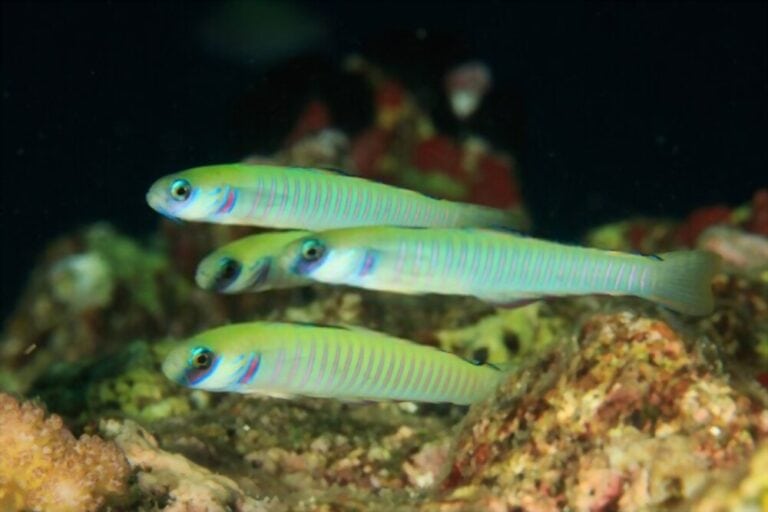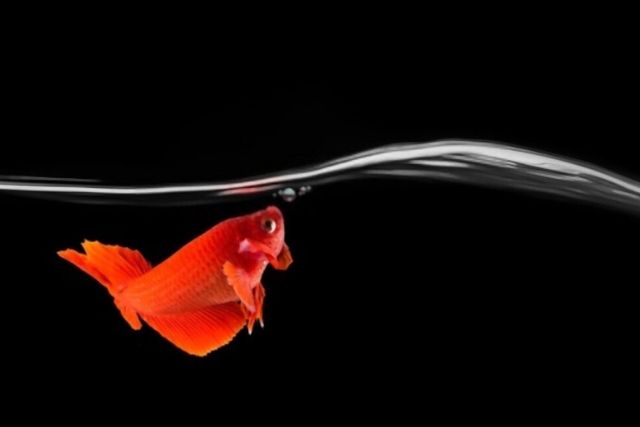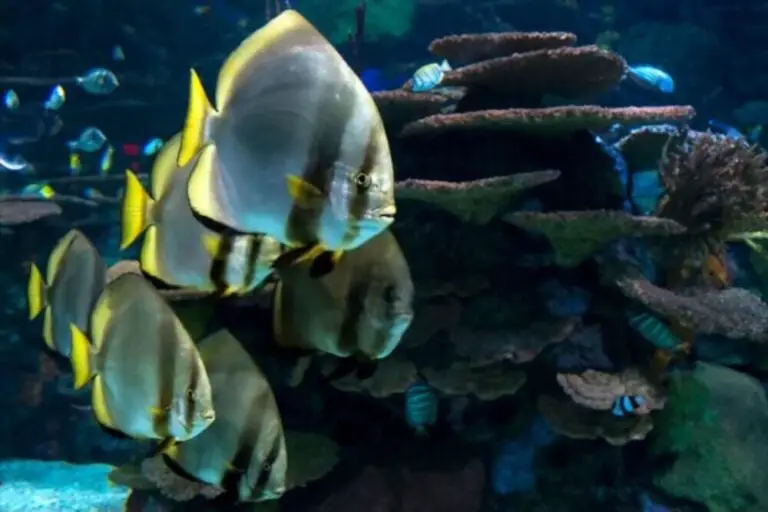Ram Cichlid Types: The List Of Popular Ram Cichlid Species
A ram cichlid is a group of fishes with many types based on coloration and physical appearance. The natural ancestral ram cichlid of all other selective bred varieties is known by the common names Blue ram, Butterfly ram, Ram ramirezi, and Dwarf cichlid.
Their natural geographical distribution is in South America, where they mainly inhabit the Amazon and Orinoco river extensions. Selective and captive breeding has created many color morphs of this fish, which are available in the aquarium trade worldwide.
Species of Ram Cichlids
Technically the actual wild ancestor blue ram cichlid has been selectively bred with mutant forms to give rise to different color morphs, which have become fixed forms by generations of captive breeding.
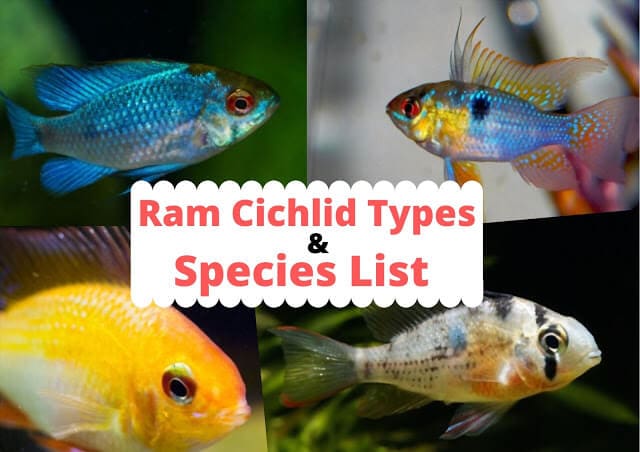
These variants share the same scientific name, which is Mikrogeophagus ramirezi, except for Bolivian ram cichlid, and it is a different species of the genus Mikrogeophagus.
All of this depicts the types that might be developed selectively, but they do not have pretty much noticeable differences except for markings and colorations. Bulleted below are the color morphs or species of the Genus Mikrogeophagus.
- Gold ram cichlid
- Angel ram cichlid
- Bolivian ram cichlid (Mikrogeophagus altispinosus)
- Holland ram cichlid
- Blue ram cichlid (Wild variety)
- German blue ram
- Electric blue ram
4 Most Popular Types Of Dartfish
Gold Ram Cichlid
Gold ram cichlid is a yellow-colored selective bred version of the Mikrogeophagus ramirezi or simply the dwarf ram. It has a striking appearance that captivates the viewers with the appealing shades of light orange-red tint.
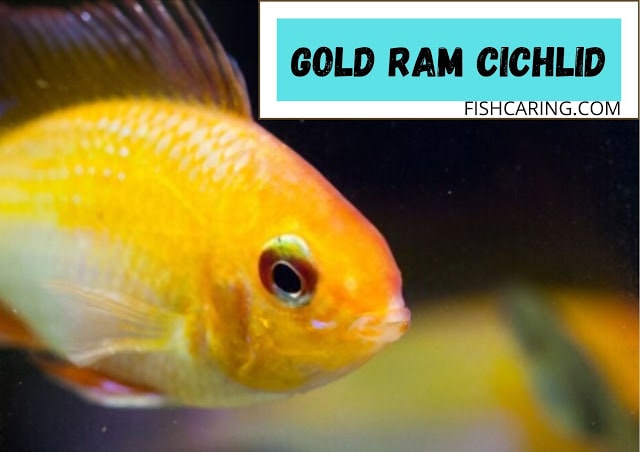
The orange-red makes a ring-like formation around the eyes, which looks as if the fish is wearing the red mascara in the eyes.
Sparking blue flecks along the iridescent lower half of the body and the fins add more attraction to this already beautiful ram. The fish’s size is almost the same as its wild counterpart, and it is 2.5 inches in length.
In an aquarium, gold ram cichlid makes a wonderful addition to the community tank and is very peaceful. But it has territorial instinct, and sometimes a little face-off happens among other rams, but that is not too intense to be potentially regarded as a threat.
Caring requires plenty of swimming space in an aquarium with a decent amount of plantation and hideouts. Being omnivorous feeders, they should be fed a varied, balanced diet.
Flakes, pellets, along with the frozen foods, and occasional feedings of live foods would make the best of the diet for Gold ram cichlids.
German Blue Ram
German Blue Ram is a spectacular variety of ram cichlid. It is one of the most popular color morphs of the dwarf ram.

It carries all the characteristic and behavioral features of dwarf ram cichlids, which we have discussed previously, and they are no different in any member of the rams.
The wild-caught variety of the German blue ram is mainly concentrated in Venezuela and Colombia’s Orinoco River basin.
As far as their appearance is concerned, they exhibit a fantastic display of colors, which add to their beauty. They are beefier than normally ram cichlids. Their sparking mixture of colors produces a magnificent and captivating appearance.
German blue ram has a yellow-colored body and the first half of the body, with the head’s front having a hue of orange. They also have a tint of green on the upper side just behind the eyes. The lower half of the body is iridescent with a bluish color, the speckles of which also extend to the fins’ base.
The most prominent feature of these rams is the vertical bars that vary in number, the most prominent thick vertical bar is the one that cuts right through the eye and down to the lower margin of the mouth.
If we talk about their fins, you will find that the yellow with its front part blacked with a vertical stripe running down. The pelvic and anal fins have more red along the lower extremities with scattered blue specks all over. Males are usually larger than females.
Electric Blue Ram Cichlid
The physical features of this variety of ram cichlid are the same as its wild-caught cousin. However, the only difference that arises is in the coloration.
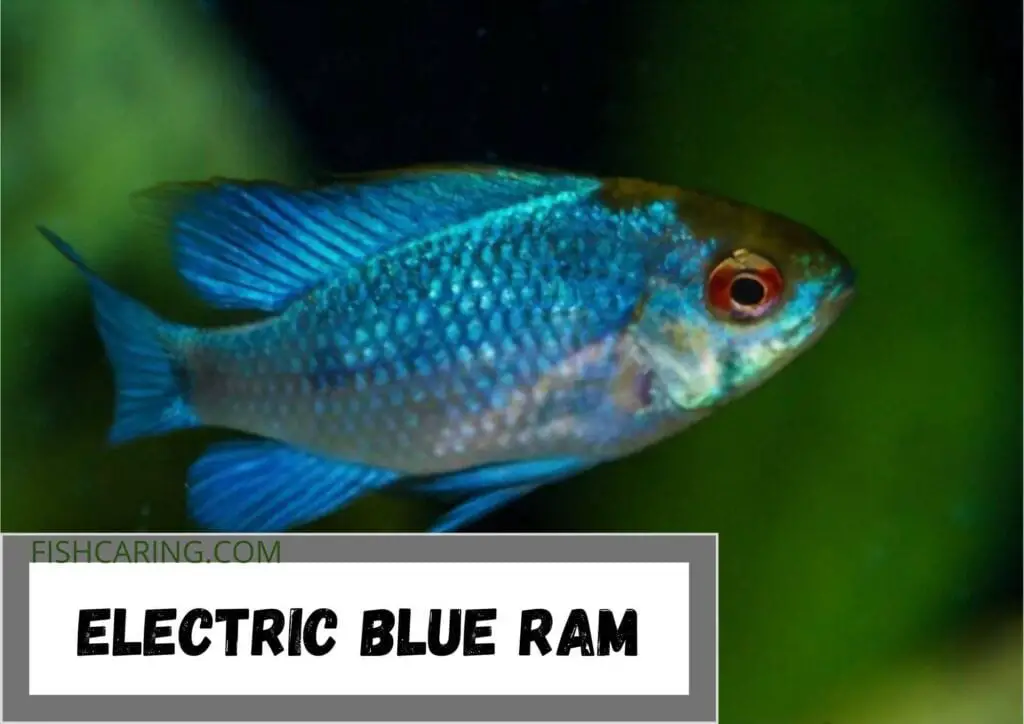
The electric blue ram is a radiantly blue colored spectacular fish with patches of red around. The eyes are orange-yellow along the front of the forehead, which captivates the viewers.
It is the latest tank breed color morph of the common dwarf ram and available since 2009. The ovoid body and long spiky fins give it the same mold as its wild type of cousin known as the blue ram.
Generally, the dwarf rams are considered hardy fishes and are not restrained by the beginners, but the electric blue ram is more sensitive than the cousin’s color morphs.
It requires no other specialized care than strict water maintenance. As far as feeding is concerned, they follow the same feeding pattern as any other ram cichlids member.
As discussed previously, flakes and frozen foods can be given as a daily part of their diet. To balance up their nutritional needs, you should also give live foods twice or thrice a week.
Bolivian Ram Cichlid
Bolivian ram is not Mikrogeophagus ramirezi. Rather it is a different species and is scientifically known as Mikrogeophagus altispinosus.
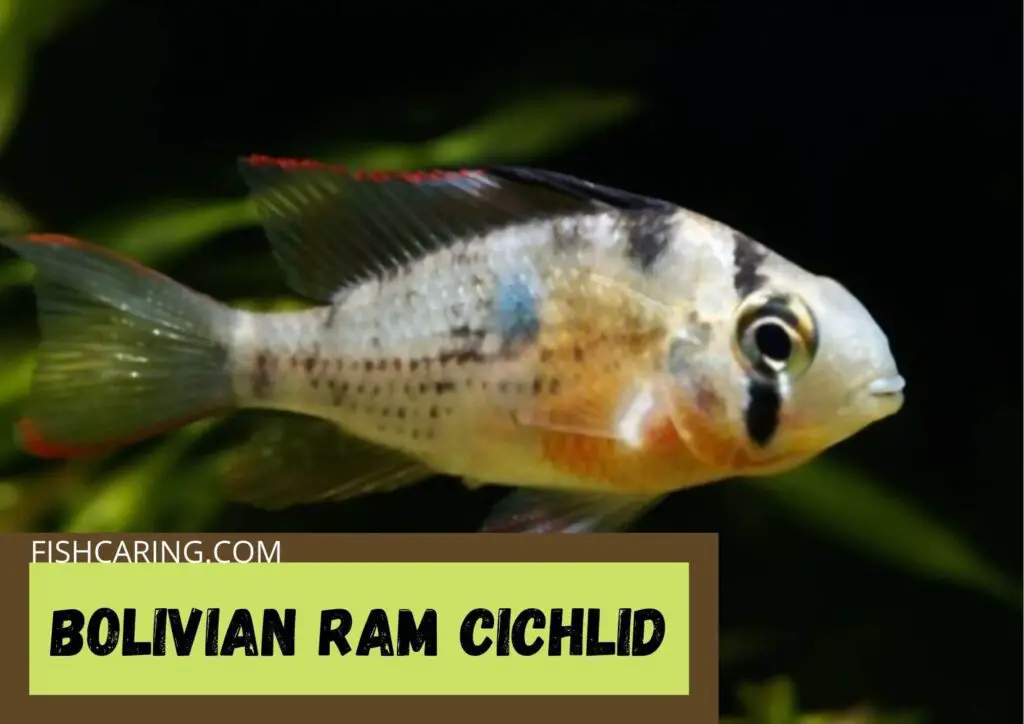
The common name Bolivian ram is true to its natural geographical distribution. It is mostly concentrated in the Amazon River basin in Brazil and Bolivia.
Naturally, they inhabit the slow-moving streams, pools, and lagoons with densely grown submerged vegetation, which shelters them, and most importantly, a variety of food.
The Bolivian rams have a very striking appearance. Their coloration is a blend of yellow, white, and shades light brown to bluish-grey.
They are mostly yellowish in color on the front half and have whitish yellow bellies on the lower half of the body. The tips of their fins are hued with orange.
In short, they beautifully display the blend of different colors, which makes them shimmer. Bolivian rams may have a prominent spot in the center just below the area of the dorsal fin.
Pointed snout and elongated rays of the dorsal fin are the characteristic features of the Bolivian ram.
They are also known for their sifting behavior because they also sift through the substrate for food like plant detritus and other small organisms. You can keep on a diet that contains flakes and pellets in the aquarium in combination with meaty foods.
Frozen foods like finely chopped brine shrimp, bloodworms, and earthworms make up a good protein source for Bolivian rams.
Live foods should be kept as an occasional part of their diet because aquarium based live foods are more likely to spread infections into the fishes.
Angel Ram Cichlid
Angel ram or also known as balloon ram cichlid and it is a manipulated variety of normal ram cichlid.
So, what is done with the rams is a kind of technique to alter their bodies and make them taller. Maintaining a spinal deformity gives them a taller and round appearance.
This deformity is maintained by limiting the intestine and other organs in a much smaller and confined cavity than its natural form.
The angel rams are not as hardy and healthy as their normal form. This truly can be expected. After all, every vital organ of the fish is just squished into a smaller space.
Angel rams are bred from already housed or raised species, which means they can easily take up commercially prepared pellets and flakes. These can be given in a blend with the frozen foods.
There is no room for overfeeding. An already deformed internal digestive system can not withstand the drastic effects of overfeeding and can prove to be an immediate killer for your angel ram cichlid.
Holland Ram Cichlid
Holland ram is nothing but a color morph of common ram cichlid. The name Holland rams are just the country’s indications, where these varieties were first produced through the process of selective breeding, or simply Holland became the major supply market for these types of ram.
I can confidently say that these rams exhibit such a beautiful outline of colors that you may indulge in thinking this is an art of an artist that comes out of the paper and starts swimming in the tank.
The coloration markings define their elegance. Not the same, but they do resemble German blue rams somewhat in markings. Their bodies can be split into the upper half and lower half because of their distinct colors.
The upper half of the Holland ram is yellowish-green, which is hued with orange along with the snout and sky blue specks scattered randomly around the eyes and mouth. On the lower half, they have distinct regular thick blue spots that further go into the fins.
Their appearance’s most prominent feature is the disruptive dark bands or lines running vertically along the whole length of their body. These are seven in number. One of these lines cut right through the eyes and go down to the lower edge of the mouth.
The first 3 of these bands are prominent and dark. Their fins are also green, with their margins transparent. The blue spots are beautifully patterned along the greenish part of their fins.
Blue Ram Cichlid
Blue ram is the common name of the natural form of dwarf ram cichlid. It is also known by many common names, including butterfly cichlid, ram, and ramirezi.
The Selective breeding of blue ram has given rise to many different color morphs of the blue ram. They include German blue ram, holland ram, Gold ram, electric blue ram, and Balloon rams.
Blue rams, German blue rams, and Holland rams are mostly sold under interchangeable names.
This is because of many similarities in their colors and markings, which mostly overpower the small morphological differences. After all, all of these varieties are nothing but Mikrogeophagus ramirezi.
The blue ram cichlids are peaceful, and they do not carry the aggression of their notorious cichlid family.
The blue rams are omnivorous feeders, which we already have discussed in this article. Their dietary staple in the aquariums is flakes and frozen meaty brine shrimp and bloodworms.
Occasional meaty treats are also important not just nutritionally but, it brings out the natural predatory instinct of the fish as well.
Bolivian Ram vs German Blue Ram
The major difference that sets them apart is their taxonomic hierarchy, where they differ at the species level. The genus of both varieties is the same.
Bolivian ram is less colorful than the German blue ram. We have discussed enough of them in this article. Given below is a quick comparison of both the rams.
| Bolivian Ram | German blue Ram |
| They are hardier and have a good ability to withstand the fluctuations | They are not so much hardy and are thought to be fragile |
| calm and very intelligent | These are more playful |
| They are larger in size | German blue rams are smaller in size than Bolivians |
| They are not that much of choosy in eating | They are fussy eaters. |
| less colorful | extremely colorful |
FAQs
How many ram cichlids can you keep together?
You can keep ram cichlids alone or in pairs. It is best to buy them as juveniles. You can buy up to 6 if you are purchasing the juveniles.
As they reach the age of maturity, allow them to pair up. Once the pairing starts, you may see a little bit of aggression between them, but this aggression is not very intense.
However, it is better to separate the pairs and shift them to the other tank. You can also keep them singly, but a pair would be better because they are good at coping with the surrounding stress.
Is ram cichlid aggressive?
Well, it is very amazing to explain this notorious aggression of the cichlid family. However, the ramirezi or ram cichlids are extremely peaceful as compared to the other cichlid fishes.
Although they still have a little bit of aggression among the same species, especially among the males over pairing up with the females, aggression is negligible if we compare it to the other cichlids.
They also exhibit territorial aggression towards the smaller tank mates trying to enter their ‘NO ENTRY’ area. Ram cichlids are very easy to get stressed in a community tank, which is why they are suggested to be kept in pairs.
The pair even feels stressed sometimes and face off against each other, but that is just a friendly face-off, and they do not hurt each other. Bolivian rams are more aggressive than the traditional dwarf ram varieties as they are a different species.
